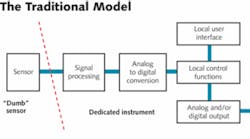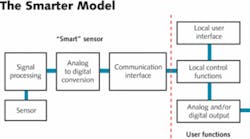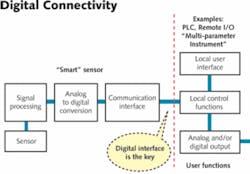Using Smart Sensing and Blind Transmitter Technology
by Dave Vollaire
• Managing measurement costs in automated water treatment systems – from desalination to zero discharge and all the piping in between – made easier by advanced controls.
Installed cost per measurement is an important factor for industrial water and wastewater treatment professionals focused on system design. Modern treatment and distribution systems are highly automated and a significant portion of equipment and installation costs belongs to measurement and instrumentation components. When these costs are removed from the equation, it becomes clear such components alone can account for up to 50% of total equipment cost. Newer technologies such as smart sensing, multi-channel, multi-parameter instrumentation, as well as blind transmitter technology, can significantly reduce the cost per measurement over traditional single-point controller schemes in automated water treatment systems.
‘Dedicated Instrument’ Model
Traditional measurement configurations in automated water treatment systems usually refer to a single-point controller scheme. These systems typically require each parameter, or sensor type, to have its own unique instrument for signal conditioning or processing, local display and output. Common measurements required in automated water treatment systems include flow, pH, ORP, conductivity/resistivity, pressure, temperature and level. Traditional sensor/instrument pairings usually consist of a primary sensing element – a “dumb” sensor – and an instrument dedicated to that particular sensor type (see Figure 1).
For example, flow sensors typically have frequency output; pH and ORP electrodes are active with high impedance mV outputs; conductivity electrodes are passive and must be “driven” – sometimes in complex ways; RTDs, pressure transducers and level sensors of various types are still different yet. In each case, an individual instrument designed for a specific sensor type provides signal conditioning and processing required to complete the measurement. In this model, dedicated instruments are necessary to accommodate unique characteristics of each sensor type, resulting in high costs for multiple instruments and for lengthy wiring and panel mounting.
Given each sensor type always requires its own unique interface, and that sensor/instrument combinations usually provide the basic functionality described above, alternative, more cost-effective measurement configurations are desirable. These exist in the form of smart sensing and blind transmitter technology.
Alternative Measurement Configurations
Smart Sensors – Smart sensing represents a more intelligent partitioning of hardware. Sensors become smarter when unique portions of front-end circuitry and signal processing are shifted from a dedicated instrument into the sensor itself. With smart sensors, the measurement signal is processed at the sensor for calibration, temperature compensation or linearization, and then transmitted digitally to a control instrument. In this method, the hardware interface has been adjusted so the necessary signal processing and analog-digital conversions are contained within the sensor instead of the instruments (see Figure 2). This configuration has two major advantages over traditional single-point measurement. The first is digital bus connectivity between sensor and instrument. The second is dramatic simplification of instrument hardware. Several cost savings benefits become evident when these advantages are explored in detail.
Digital bus connectivity (see Figure 3) allows several sensors of similar and/or different types to share the same wiring in daisy-chain and/or multi-drop configurations. In the daisy-chain configuration, sensors are connected sequentially to each other. This is especially useful when multiple sensors will be installed in relative proximity to one another. In the multi-drop configuration, a single run of cable is used with sensor branches connected via inexpensive NEMA-4X junction boxes. This configuration is most advantageous when wiring across walkways, driveways, or multiple floors of a building. Both daisy-chain and multi-drop wiring configurations can be combined in systems containing multiple sensors (see Figure 4).
This flexibility can radically simplify installation and reduce wire and conduit usage when compared to point-to-point wiring of individual sensors to instruments. Considering that wiring and conduit can range from $5 to $1,000 per foot or more, cost savings can be substantial.
As sensors become smarter, compatible instrument hardware can become simpler and more versatile. This is because an instrument designed for use with smart sensors has to only provide the functionality common to all measurements, which is limited to user interface, control and output features. This simplified architecture makes possible multi-parameter instruments that utilize software to accommodate the individuality of each measurement type. Compact multi-channel instruments for various parameter combinations can be mixed and matched with several sensor types simultaneously. Many smart sensors can be connected to a single instrument, resulting in fewer instruments which consume less panel space.
Smart sensors for the most common measurement types discussed earlier – flow, pH, ORP, conductivity/resistivity, pressure, temperature, and level – are all available. Compact multi-channel instruments for any combination of these and other parameters are also on the market.
Blind Transmitters – Blind analog transmitters are another method that can reduce cost per measurement in automated water treatment systems. The basic premise behind these transmitters is taking the output of a sensor directly into a control system without having to go through an intermediate instrument. Because they contain the sensor and signal processing in a single package, they eliminate the cost of a separate display and processor. While blind transmitters have been around for years, earlier technology held inherent drawbacks such as drift, the need for constant recalibration, and requirements for special equipment. The evolution from transmitters built on discrete components to transmitters with microprocessor-based technology resulted in a new type of transmitter that solved these earlier problems. These mini computers didn’t require components that were subject to drift. The result was a more stable, reliable output that met the demands of modern automated water treatment systems.
With today’s advanced transmitter technology, water treatment professionals can derive the benefits of the original blind transmitter concept with a higher degree of accuracy, and use it as cost-saving measurement alternative to traditional single-point controllers. Newer microprocessor technology incorporates local process displays, push button calibration, and eliminates the need for costly simulators to aid calibration. These transmitters can send process measurements from different areas in a plant to a central PLC where process control decisions can be made based on transmitter feedback. Using the universal 4-20 mA signal, the user can take any process parameter, scale the unit measurement over the 4-20 mA span, and obtain a linear representation of measurement back to the PLC. These capabilities, combined with their high reliability and elimination of unnecessary displays, make blind transmitters an excellent alternative to the single-point controller measurement configuration.
Case Studies
To evaluate alternative measurement configurations in terms of real-time costs, it’s necessary to focus on actual installations and compare the existing equipment costs of these traditional measurement systems to smart sensors and blind transmitters.
A Smart Comparison – In a typical desalination demo installation using a single-point controller measurement scheme, an actual installed system incorporates 16 dedicated instruments with 16 corresponding sensors, including four flow, four pH, two conductivity, three pressure, and three temperature, with a total length of sensor conduit of 350 feet. The equipment cost for this traditional measurement system totaled $12,000. If the same system used smart sensors and 4- or 6-channel, multi-parameter instruments, the equipment cost would be less than $9,000. Additional benefits of the smart sensing method would include reduction of instruments from 16 to three or four, resulting in smaller panels, reduction of wiring and conduit usage by 100-200 feet, and identical instrument hardware for all channels.
A Blind Comparison – To cover the same 16 sensing points using blind transmitters, the total cost will be under $8,000. In addition, there will be no need for instrument panels. The only wiring needed will be to the central data acquisition system or PLC.
Conclusion
Smart sensors, digital bus connectivity, multi-channel, multi-parameter instrumentation, and blind transmitters can significantly reduce the cost per measurement in automated water treatment and distribution systems. In the case of smart sensors, digital connectivity benefits include fewer instruments to purchase and install, more panel space or reduction of panel size, improved noise immunity over longer distances, and multiple wiring options beyond the traditional point-to-point method. Blind transmitters allow wiring directly from the sensor to a controller without necessity of wiring to a separate instrument, thus eliminating the cost of unnecessary displays. In both cases, equipment costs plus installed costs result in total cost savings over traditional measurement schemes. And every cost saving innovation improves the viability of all treatment projects – from desalination to zero discharge systems.
About the Author: Dave Vollaire is product manager for instrumentation at GF Piping Systems, a Tustin, CA-based unit of Georg Fischer that supplies a full range of plastic pipe, fittings, tubing, valves, actuators, rotameters, fusion machines, secondary containment, tank linings, heat exchangers, custom products, and sensors and instrumentation for industrial process control. Contact: 800-854-4090, [email protected] or www.gfpiping.com




